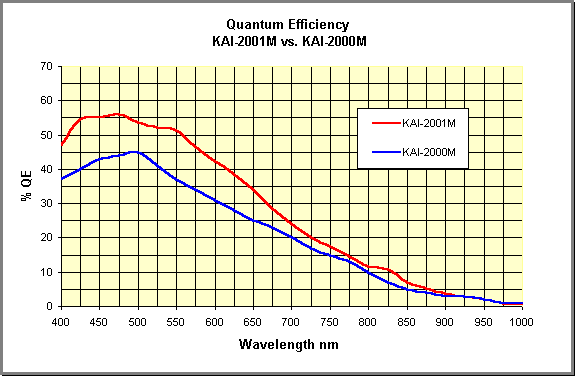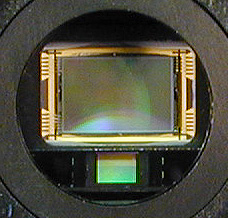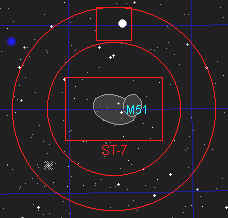Product Improvement
Announcement
8/18/03
ST-2000XM
Product Improvement
Announcement
![]()
8/18/03
Two major improvements were made to the ST-2000XM camera in 2003. The first was a switch to the higher QE KAI-2001M CCD in January. This CCD has approximately 25% to 40% higher QE (10% to 15% absolute) across the visible spectrum than the former KAI-2000M. The second improvement is introduced with this announcement. Beginning August 18, 2003, all new ST-2000XM cameras will include a TC-237H built-in guiding CCD instead of the TC-211. This improvement is the same as the upgraded autoguiding installed on the larger ST-8XE, ST-9XE and ST-10XE cameras. Both of these improvements come at no additional increase in the price of the ST-2000XM camera.
Improved Quantum Efficiency
 |
The QE of the new KAI-2001M CCD used in the ST-2000M Camera since January 2003 is significantly higher across the visible spectrum than the former KAI-2000M CCD. Typical of the Kodak interline CCDs, this improvement is greater towards the blue and green poriton of the spectrum and smaller towards the red and near IR portion of the spectrum. Nevertheless, the camera is quite capable of H-alpha imaging through a narrow band filter. For examples of some H-alpha images with the new CCD click here. The KAI-2001M CCD is used in cameras with serial numbers beginning with "203..."
Improved Autoguiding with a Built-In TC-237H Autoguider
 |
Built-in Autoguider |
Array | Pixel Size | CCD Dimension -------- ( Area ) |
Field of View at 80" FL |
Number of Pixels |
| TC-237H CCD | 657 x 495 | 7.4 x 7.4 u | 4.9 x 3.7 mm ----- 18.3 mm2 |
8.2 x 6.2 arcminutes ( 51 arcmin2 ) |
325,215 | |
| TC-211 CCD | 192 x 164 | ~ 15 u | 2.6 x 2.6 mm ----- 6.8 mm2 |
4.5 x 4.5 arcminutes ( 20 arcmin2) |
31,000 |
The TC-237 autoguiding CCD is seen here just below the larger imaging CCD. The TC-237H is the same CCD used in our $1300 ST-237A imaging camera and $2300 STV autoguider. The TC-237H is 2.7X larger than the TC-211 CCD which means there is a more than double the chance you will find suitable guide stars anywhere you happen to be looking without having to hunt. The sample images below demonstrate the difference in field of view.
| Field of View of TC-211 autoguider through an 8" SCT at F/7 30 second unguided image centered on NGC 2903 taken with the TC-211 tracking CCD. 192 x 164 pixels at ~15 microns (unbinned). |
| Field of View of TC-237 autoguider through an 8" SCT at F/7 30 second unguided image of the same area taken with the TC-237 tracking CCD demonstrates the benefit of having 2.7X the field of view: An increase in the number of potential guide stars stars. 328 x 247 pixels at 14.8 microns (binned 2x2). |
In the tracking configuration, the TC-237H CCD will normally be binned 2x2 for increased sensitivity. When binned 2x2 the field of view remains 2.7X that of the TC-211 however as the pixel size is increased to 14.8 microns. The user may also image with the TC-237 CCD in high resolution (unbinned) mode if desired.
Even with a smaller field of view, however, the TC-211 remains an excellent autoguider for the ST-2000ME cameras. With ~15 micron pixels and low noise performance the TC-211 unbinned is more sensitive than the TC-237 in unbinned mode and as sensitive as the TC-237 in binned mode. In tests performed under moderate light pollution with an F/6 telescope, random pointing of the telescope in areas of the sky away from the Milky Way, we found stars on the TC-211 image bright enough to guide on 95% of the time. ThsSky software from Software Bisque automatically generates finder charts showing the correct placement of the guiding CCD field of view relative to the imaging CCD's field of view. Using this tool to plan your nights imaging is a great compliment to the self-guiding cameras.
 |
Previously, the camera had to be oriented so that the X and Y dimensions of the tracking CCD were aligned with the RA and DEC of the telescope, limiting the possible rotation of the camera to four possible positions around a target at at 90 degree steps. Now, with CCDSoftV5, the autoguiding capability of the TC-211 (and TC-237) is improved so that the camera may be placed in any orientation relative to the telescope's RA and DEC, allowing a full 360 degrees of rotation around a target for easier guide star acquisition. |
Of course, guiding with either the TC-211 or the TC237 tracking CCD means that the imaging CCD spends 100% of its time and quantum efficiency gathering the image. You are not required to compromise for half the quantum efficiency or twice exposure time as you might with other self-guiding designs.
Upgrades
ST-2000XM owners who purchased a new ST-2000XM camera from SBIG or from an authorized
SBIG stocking dealer within 30 days of the date of this announcement may receive a free
upgrade to the TC-237H autoguider. Contact SBIG with your details and a copy of your
original sales receipt. Upgrades to a TC-237H autoguiding CCD are available to all
other ST-2000XM owners for $395. Upgrades to the new KAI-2001M imaging CCD are
available for $995. The KAI-2001M CCD is already installed in cameras with serial
numbers beginning with "203..."
Complete Systems
As of August 2003, each new ST-2000XM camera system INCLUDES at no additional cost:
More ST-2000XM links:
ST-2000XM Sample Image Page ST-2000XM On Line Product Catalog Page Price List
Price and specifications are subject to change without notice.
Revised: August 19, 2003 11:21:05 AM.
Copyright © 2003 Santa Barbara Instrument Group, Inc. All rights reserved.
Please report any problems with this page directly to the Webmaster